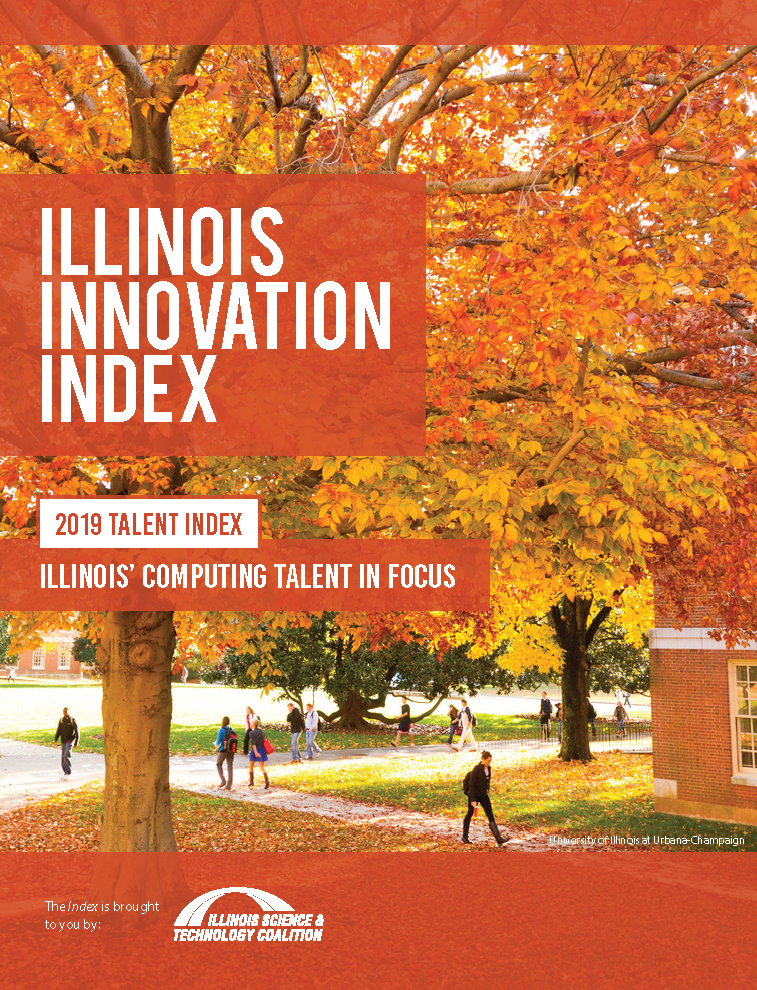2019 stem talent Index
Illinois’ computing talent in focus
Executive summary
Each year, the Illinois Innovation Index takes stock of the state’s talent landscape in vital science, technology, engineering, and mathematics (STEM) areas. Over its past several issues, the Talent Index has highlighted the state’s strength in computer science; retention successes and challenges; and the growing share of Illinois’ workforce employed in STEM occupations. This issue builds upon the work of previous issues, diving deeper into key computer and data science fields; examining retention and placement of recent graduates; highlighting underrepresentation and immigration challenges; and much more.
Despite declining total college enrollment since 2013, Illinois produced more STEM degrees in 2018 than ever before. The state also maintained its status as the second-leading producer of computer science graduates in the country, though output fell slightly in 2018. Adding to Illinois’ strength in computing areas is computer engineering, a field combining elements of computer science and electrical engineering. Degrees in computer engineering have more than tripled since 2010.
Illinois is also a national leader in data science, an interdisciplinary field applying scientific methods to data analysis. The state ranks 5th nationally in the production of data science-related degrees. Retention of these graduates is key to Illinois economic competitiveness. Recent graduates in data science are nearly six-times more likely to work in Chicago than any other city. These professionals are widely dispersed among companies outside traditional tech industries, most commonly in financial services,
insurance, and healthcare.
Overall, Illinois’ STEM workforce is the sixth largest in the nation. Over the past five years, STEM jobs have grown more quickly in Illinois than nationally. Among the fastest growing STEM job areas is life sciences, including medical scientists. STEM jobs in life sciences have seen double-digit annual growth over the past five years, despite the narrative that Illinos is shipping these jobs out of state.
Though Illinois is a leader in computing talent production, the state has struggled to grow jobs in vital software development and programming occupations. Illinois’ workforce in these occupations ranks 8th nationally, and has grown more slowly than the national average. The discrepancy between Illinois’ production of computing talent and the size of its software development and programming workforce presents an opportunity to grow jobs in the state.
Improving diversity and inclusion in the STEM pipeline, and creating pathways for international students to remain in the state after graduation, are key to Illinois’ economic competitiveness. Despite some progress, women, African-American, and Hispanic or Latino students and professionals are underrepresented in STEM fields. Widening access to STEM fields improves equity, while strengthening the state’s pool of talent. Illinois’ universities attract talent from around the globe. As a result, international students make up a larger share of Illinois’ STEM degree production, compared with the national average. Illinois’ concentration of international students earning STEM degrees means the state is in a unique position to benefit from federal immigration reform.
Key Findings
STEM TALENT SUPPLY
-
- Despite declining total college enrollment in Illinois, the state set a new record with 24,555 STEM bachelor’s, master’s, and doctoral degrees awarded in 2018. Illinois ranks 7th among states in STEM degree production.
- As a share of all degrees, Illinois produces slightly fewer STEM degrees than the national average. In 2018, 19.2 percent of all degrees were awarded in STEM fields, compared with 19.9 percent nationally. However, the state has closed the gap since 2013, when just 15.2 percent of degrees were awarded in STEM, compared with 16.5 percent nationally.
- Illinois is a national leader in computer science. Between 2013 and 2017, the state’s production of computer science more than doubled. Despite a decline in 2018, Illinois remains the second largest producer of computer science degrees in the nation.
- Adding to Illinois’ computing talent strength is computer engineering, a degree that incorporates elements of computer science and electrical engineering. Growth of computer engineering degrees in Illinois has outpaced the national average, more than tripling since 2010.
- Illinois’ strength in both computer science and mathematics has positioned the state as a national leader in data science, an emerging interdisciplinary field that uses scientific methods to extract insight from a variety of data sources. In 2018, Illinois produced 4,058 degrees in data science-related fields, fifth most among states.
- Illinois ranks 4th nationally in MBA production. Though not typically considered a STEM degree, the quantity and quality of business talent in the state is vital to entrepreneurial activity.
- Illinois attracts STEM talent from much of the midwest, while exporting talent to populous states and those with established tech industries. Between 2013 and 2017, the largest net inflow of STEM talent to Illinois was from Iowa, Ohio, Massachusetts, Kentucky, and Kansas. Conversely, the largest net outflows were to California, Texas, North Carolina, Florida, and Washington.
- Compared with the national average, international students make up a larger share of STEM degrees in Illinois. In 2018, international students were awarded 29.2 percent of STEM degrees, compared with 20.3 percent nationally. The share of STEM degrees in Illinois means the state stands to benefit greatly from federal immigration reform.
- Access to STEM degrees, and the high-paying jobs for which they prepare students, is not equally distributed among all Illinoisans. Despite some recent progress, women (36.1 percent), African-American (5.7 percent), and Hispanic or Latino (11.6 percent) students remain underrepresented in STEM degree fields.
STEM TALENT DEMAND
-
- Illinois’ STEM workforce is among the largest in the nation. In 2018, 346,460 Illinois professionals were employed in STEM jobs, sixth-most among states nationally.
- Illinois’ STEM workforce grew markedly in 2018, with the state adding 8,380 new STEM jobs.
Over the past five years, STEM jobs have grown by 2.7 percent annually, outpacing national
growth of 2.3 percent over that period. - Both in Illinois and nationally, STEM jobs are dominated by computer-related occupations.
In 2018, 168,540 Illinois professionals were employed in computer-related STEM
occupations, nearly three-times more than any other STEM field. - Software developers and programmers make up 38.1 percent of all computer-related jobs in
Illinois, lagging the national average of 39.5 percent. The state ranks 8th nationally for the
total number of software development and programming jobs, highlighting a key gap
between Illinois’ computing talent production and available jobs in the state. - Illinois’ retention of data science talent is strong, with recent graduates nearly six-times
more likely to work in Chicago than any other city. Data scientists working in Illinois are
widely dispersed among companies outside traditional tech industries, most commonly in
financial services, insurance, and healthcare. Illinois employers of recent graduates in data
science are led by AbbVie, State Farm, Blue Cross Blue Shield, Discover, and Accenture. - Illinois ranks 6th nationally in data science-related jobs. However, over the past five years,
jobs in the field have grown more slowly in Illinois than nationally. Since 2014, jobs in data
science-related occupations have grown by 2.4 percent annually, compared with 4.8 percent
nationally. - STEM jobs in life sciences have grown significantly more quickly in Illinois than nationally.
Between 2014 and 2018, STEM jobs in life science grew by 10.8 percent annually, nearly
four-times faster than the national average. The number of medical scientist jobs in Illinois
has more than doubled since 2014. - Though Illinois ranks 6th by the size of its STEM workforce statewide, large disparities exist
between areas within the state. Champaign-Urbana; Peoria; Lake County-Kenosha County;
and Chicago-Naperville-Elgin metropolitan statistical areas (MSA) all exceed the state
average for the share of all jobs in STEM. - Foreign-born professionals are integral to the Illinois’ innovation economy. Compared with
the native-born population, foreign-born professionals are nearly twice as likely to enter
STEM occupations (8.3 percent vs. 4.9 percent), and significantly more likely to found
incorporated companies (4.9 percent vs. 3.2 percent). - Following the trend of degree attainment, diversity and inclusion in Illinois’ STEM workforce
is lacking. Women (26.2 percent), African-American (4.8 percent), and Hispanic or Latino
(5.4 percent) professionals remain underrepresented in Illinois’ STEM jobs.
Archive
2018 – Talent Index
Computer and data science lead the way. New analysis shows retention is strong among recent grads.
2017 – Talent Index
STEM, Computer science degrees reach record high
2016 – Talent Index
A comprehensive look at STEM degrees, talent migration, and skills in demand
2015 – Talent Index
New analysis sheds light on STEM talent supply and demand in Illinois
2014 – Talent Index
Illinois sees continued growth in high-tech businesses and jobs
2014 – Talent Index
STEM attainment in Illinois and talent migration trends in Chicago
2013 – Talent Index
Business climate in Illinois and metropolitan Chicago: Indicators and recent trends
2013 – Talent Index
Talent in Illinois and Chicago: Data and recent trends

